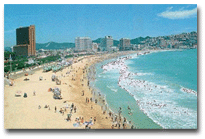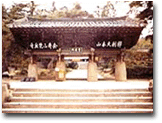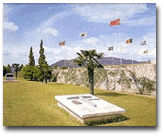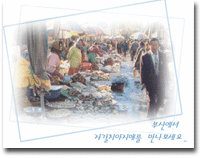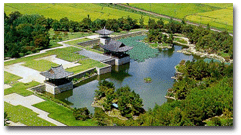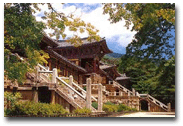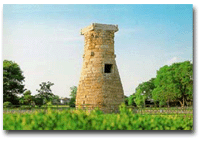|
|
|
|
Pomo Temple |
|
|
U.N Memorial Cemetery |
It is the cemetery for the war dead of 16 combat supporting countries
and 5 medical supporting countries under the U. N. Forces, who died for our
country during the Korean War. |
|
Chagalch'i
Market |
The market started to be widely known among all koreans avter the Korean War in the 1950's, producing the comfort and pleasant name of "Chagalch'i aunts". You can feel the live of Busanians here. Located at the southern seashore of Namp'o-dong, the market is always crowded with customers and Chagalch'i men and women who speak a unique local accent. |
|
|
|
|
Pomun Lake Resort |
|
|
Pulguksa Temple |
This temple is known to have been constructed from AD 751 to AD 774 on the site of an existing temple built some 200 years earlier by King Peophung, the first Silla king to adopt Buddhism as the state religion. Originally consisting of more than 80 buildings, ten times as big as today's surviving temple, Pulguksa was the center of Silla Buddhism and one of the largest Buddhist complexes of its time in East Asia. The name Pulguksa literally means the Temple of Buddhist country, or their ultimate goal of Western Paradise or Nirvana/enlightenment. As a matter of fact, the layout of this temple depicts how to reach enlightenment. |
|
Sokkuram |
Established on the slopes of Mount T'oham in the 8th century, the Sokkuram cave contains a monumental statue of Buddha looking at the sea in the bhumisparsha mudra position. With the surrounding portrayals of gods, Bodhisattvas and disciples, realistically and delicately sculpted in haut relief and bas relief, it makes up a masterpiece of Buddhist art in the Far East. The Temple of Pulguksa, built in 752, and the cave form a body of religious architecture of exceptional significance |
|
Cheomsungdae |
Literally meaning "Star Gazing Tower." this stone astronomical abservatory is commomly accepted as the most important structural remains in Korea and dates back to the three kingdom period prior to the unification. This observatory is considered the oldest existing observatory in the Far East. Having become symbolic of Korea itself, Chemsungdae by the Korean government as National Treasure N0.31, this 29 foot stone observatory is mounted on a 17 food square foundation. It is believed that a ladder was used to reach this entrance as worn on the stone can be observed. |
|
|
|
|
|
|
|
Busan Country Club |
Located in Keumjeong-gu, Busan country club is
always crowded by golf manias in and out of Korea and known as a best place due
to the good facilities. It is famous not only because of the best green field
but also of the field not frozen even in winter. You can feel the green field
any time you visit this place. Total hole number: 18holes 72. Total course:
6,882 yards . |
|
Tongnae Benest Golf Club |
As being internationally famous, Tongnae country
club is one of the best clubs due to the large-field courses and soft grass. It
is always crowded by members of the club. Total hole number: 18 holes 72. Area:
1,550,000 square meters. Total course: 7,118 yards |
|
Kyongju
Country Club |
Tel
: +82-(0)561-745-2227~8 |
|
Garden Country Club |
Tel
: +82-(0)561-740-5161~2, 740-5494 |
